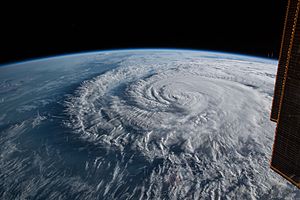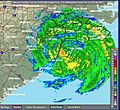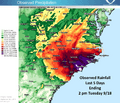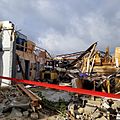Hurricane Florence facts for kids

Hurricane Florence was a very powerful tropical cyclone that caused a lot of damage in the Carolinas (North and South Carolina) in September 2018. This storm was a "Cape Verde hurricane," meaning it started near the Cape Verde islands off the coast of Africa. It threatened the East Coast of the United States with major and dangerous flooding. Florence was the sixth named storm, the third hurricane, and the first major hurricane of the 2018 Atlantic hurricane season.
Contents
How Florence Formed and Grew
Hurricane Florence began as a tropical wave that moved off the coast of Africa on August 30, 2018.
From Wave to Storm
On August 31, this tropical wave became a tropical depression. The very next day, September 1, 2018, it strengthened into Tropical Storm Florence.
Becoming a Major Hurricane
Florence continued to gain strength. By September 5, it became a major hurricane. Later that same day, it grew into a powerful Category 4 hurricane. At this point, its winds were estimated to be around 130 miles per hour (209 km/h).
Changing Strength
After reaching its peak, Florence weakened for a short time, becoming a strong tropical storm. However, it soon strengthened back into a hurricane. This time, its winds reached an incredible 140 miles per hour (225 km/h), making it even stronger than before. Post-analysis later showed its winds might have been as high as 150 miles per hour (240 km/h).
Preparing for the Storm
As Florence approached, people in its path had to get ready for its arrival.
States of Emergency
The Governors of North Carolina, South Carolina, and Virginia all declared a state of emergency for their states. This meant that they were preparing for a serious event and could use special resources to help people. It became clear that the hurricane might hit North or South Carolina as a major storm.
Evacuations and Warnings
On September 10, 2018, people living in certain areas of North Carolina, South Carolina, and Virginia were told to leave their homes. These were called mandatory evacuations. On September 11, 2018, warnings were put out for the coastlines of North and South Carolina, letting people know that a tropical cyclone was coming.
Florence Makes Landfall
Hurricane Florence finally reached land on September 14.
Slow and Rainy
When Florence made landfall, it was a Category 1 hurricane. It moved very slowly, only about 7 kilometers per hour (4 mph). This slow movement meant that it dropped a huge amount of rain over the areas it hit. The storm also pulled energy and water from the warm Gulf Stream near the coast for about a day. Once it moved further inland, it weakened into a tropical depression.
Damage and Impact
Hurricane Florence caused a lot of damage and had a significant impact on the affected areas.
Cost and Lives
The total damage from Hurricane Florence was estimated to be around $24 billion (in 2018 USD). Sadly, 53 people lost their lives because of the storm.
Retirement of the Name Florence
Because of the severe and very expensive damage it caused, especially in the Carolinas, the name Florence was officially retired.
Why Names are Retired
On March 20, 2019, the World Meteorological Organization decided that the name Florence would never be used again for another Atlantic hurricane. This is done for storms that cause extreme damage or many deaths, as a way to remember their impact and avoid confusion in the future. The name Francine will replace Florence for the 2024 hurricane season.
Images for kids
-
Florence viewed from the International Space Station on September 10
-
Flooded farmland in Duplin County, North Carolina after Florence
See also
 In Spanish: Huracán Florence para niños
In Spanish: Huracán Florence para niños









